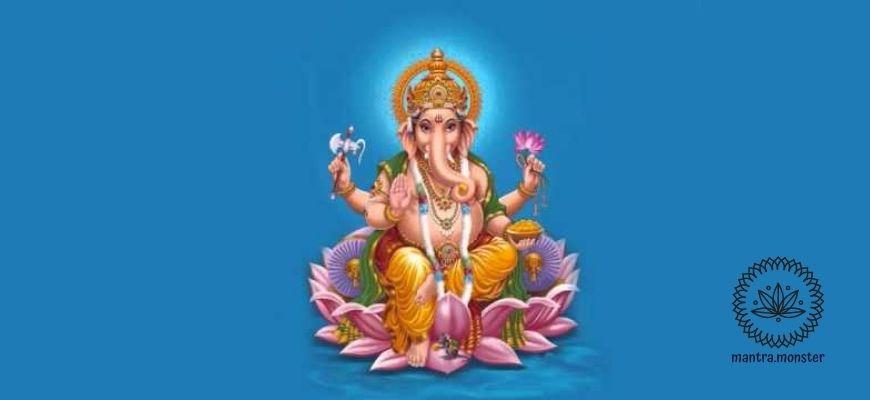Om Shri Ganeshaya Namah mantra translation:
“Ganesha, I pray to you.”
Ganesha prayer meaning:
Om – represents the mysterious and sacred cosmic energy that is the substratum of all the beings and all the things of the entire creation. When recited, this ancient sound vibrates at the frequency of 432 Hz – the same healing vibrational frequency found in all things throughout nature.
Shri – translates as ”Shrim” which is the bij mantra;
Ganeshaya – signifies the concept of the bij;
Namah – represents “I salute” or ”to bow.”
Chanting benefits:
A Sanskrit mantra consists of words that hold a precise meaning, or sounds called bijas, that contain non-literal translatable meaning, but sacred vibration. What is happening when you chant a mantra (with sincere devotion) over and over is that you are matching your own vibrational frequency to that of the Sanskrit mantra and its purpose (abundance, wealth, health, success, prosperity, knowledge).
Chanting of this Ganesh mantra ensures success in all the new ventures that one wishes to undertake. Daily reciting of this mantra improves discipline and mental power and removes all kind of hindrances and obstacles. Also, this mantra helps start incomplete or stopped projects.
More information:
Lord Ganesha is known as the God of Success and Prosperity and the Remover of Obstacles. He is also known as the destroyer of evils and the god of knowledge, education, wisdom, wealth, prosperity and domestic harmony. In India, no new undertaking, whether it is a marriage, a new business, a new job, taking an exam, spiritual practice or any other endeavor, is started without first making an offering or prayer to Lord Ganesha and asking for His blessing.
He is known in numerous forms and by a number of names, and some of the names are Vignesha, Pillayar, Vinayak, Lambodara, Ekadenta, Gajanana. He is also called Vigneshwara or Vighnaharta, the Lord and destroyer of obstacles and Ganapati (Leader of the Ganas, a fierce army). Devotees also worship him asking for buddhi (intelligence) in undertakings, and siddhi (success).
Moreover, He is also the destroyer of selfishness, vanity, and pride. Ganapati is the personification of material universe in all its numerous magnificent manifestations. All Hindus worship Him regardless of their sectarian belief, Vigneshwara is both the starting of the religion and the meeting ground for all Hindus. In addition, Vigneshwara happens to be one of the most worshiped deities in Sri Lanka and Nepal. Lord Ganesha is also identified with the Sanskrit symbol “Aum”, and signifies the unity of the Great Being, the elephant, with the small being, the man. It is the blending of the macrocosm and microcosm, of a drop of water with the ocean and of the divinity with individual soul.
He has 2 wives, one named Riddhi (prosperity) and the other named Siddhi (success) . Of course, the devotee who pleases the Lord automatically comes into the good books of his two wives!
Representations of Ganesha show many variations and distinct patterns changing over time. Lord Ganesha may be depicted dancing, standing, heroically taking action against demons (asuras), sitting down or on an elevated seat, playing with his family as a boy, or engaging in many contemporary situations. Also, He has been portrayed with one tusk, while the other one is broken.
The 2 tusks represent the 2 aspects of human personality – emotion and wisdom. The right tusk signifies wisdom and the left tusk signifies emotion. The broken left tusk conveys the idea that the devotee must conquer emotions with wisdom to attain perfection. Furthermore, Lord Ganapati is illustrated as a big-bellied, yellow or red god with 4 arms and the head of a one-tusked elephant, riding on, or attended to by a mouse. Also, He is usually depicted sitting down, with one leg raised in the air and bent over the other. Frequently, His name is prefixed with the Hindu title of respect and adoration, ”Sri” or ”Shree” .
Ganesh Chaturthi is a fantastic festival, honoring the birth of Vigneshwara. According to Hindu calendar, this festival is observed in the month of Bhaadrapada, starting on the 4th day of the waxing moon (shukla chaturthi). The date commonly falls between 19th of August and 20th of September.








